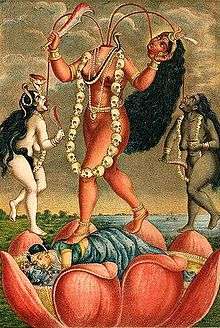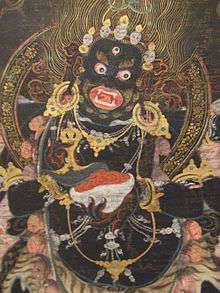Mundamala


Mundamala (Sanskrit: मुण्डमाला, muṇḍamālā), also called kapalamala or rundamala, is a garland of severed human heads and/or skulls, in Hindu iconography and Tibetan Buddhist iconography. In Hinduism, the mundamala is a characteristic of fearsome aspects of the Hindu Divine Mother and the god Shiva; while in Buddhism, it is worn by wrathful deities of Tibetan Buddhism.
Hindu iconography
Fearsome goddesses
The mundamala is often found in the iconography of the Mahavidyas, a group of ten fearsome Tantric goddesses.[1] Kali, the foremost Mahavidya, often wears a garland of freshly severed heads. The blood from her bleeding garland bathes her nude body. The number of heads in the mundamala is generally described as fifty.[2] Other Mahavidyas like Tara, Chhinnamasta, Bhairavi, Dhumavati and Matangi are depicted or at least described wearing mundamalas; the goddess may also hold a severed head or skull (kapala) in her hand.[3][4][5][6][7] In description of Bhairavi, the heads are said to be so fresh that they vomit blood over her breasts.[8]
Another fierce goddess depicted often wearing the mundamala is Chamunda.[9]
Shiva
.jpg)
The god Shiva and his fierce manifestations are often depicted wearing the mundamala; Shiva is covered with ashes and skulls adorn him.[10] Pahari paintings often picture Shiva's family making mundamalas. His son Kartikeya helps him or his mother Parvati handing over a head, while the latter threads them. Another scene depicts the parents making the mundamala, while Kartikeya and his brother Ganesha play nearby.[11][12]
The ferocious manifestation of Shiva, Bhairava ("The Terrible") as well as Bhairava's various forms like Vatuk-Bhairava are depicted wearing the mundamala.[13] Other fierce forms of Shiva wearing the mundamalas include Virabhadra, Gajasurasamhara ("Slayer of the Elephant demon") and the eight-armed Aghoramurti.[14][15][16]
Symbolism
The fifty or fifty-two heads or skulls in the mundamala are described to symbolize the letters of the Sanskrit alphabet in Kali's iconography, thus signifying the wearer Kali as sabda Brahman, Ultimate Reality recognized as Sound and the primal sound of the sacred syllable Om.[17] Another interpretation links the mundamala symbolizing the heads of foes and demons slain by the wearer goddess in battle.[4] The mundamala in the context of Chhinnamasta's iconography is said to signify her victory over Time and fear of Death.[18]
In Shiva's iconography, the mundamala represents the continual creation and destruction cycles of human existence.[10]
Buddhist iconography

Various wrathful deities, including the dharmapalas, wear the mundamala, a five-skull crown and human or animal skins.[19] Manifestations of Akshobhya are generally fearsome and are depicted wearing the mundamala as well as skulls and serpents. These include Acala, Heruka, Chakrasamvara and Yamantaka.[20] Mahakala, who from adopted from the Hindu Shiva also wears the mundamala.[21] Hevajra and his terrific emanations also adore the mundamala.[22]
Wrathful Buddhist goddesses like Marichi, Vajravarahi, Guhyeshvari and dakinis are depicted wearing the mundamala.[23][24][25]
The Kumari, a girl worshipped as a goddess in Nepal, is identified with Vajravarahi by Buddhists. She wears a silver mundamala signifying her identity as Vajravarahi and her ferocious nature.[26]
Like in Hindu iconography, the mundamala symbolizes the Sanskrit alphabet in Buddhist iconography too.[27] In Chakrasamvara's iconography, it symbolizes the "abandonment of phenomenal appearances" as well as his union with his consort Vajravarahi (when depicted with him).[28]
Notes
- ↑ Kinsley p. 63
- ↑ Kinsley pp. 67–8
- ↑ Kinsley p. 98
- 1 2 Kinsley p. 153
- ↑ Kinsley p. 167
- ↑ Kinsley p. 180
- ↑ Kinsley p. 246
- ↑ Kinsley p. 171
- ↑ Art; Pal, Pratapaditya (1985). Art of Nepal: A Catalogue of the Los Angeles County Museum of Art Collection. LACMA in association with University of California Press. pp. S32. ISBN 9780520054073.
- 1 2 Daniélou, Alain (1991). The Myths and Gods of India: The Classic Work on Hindu Polytheism from the Princeton Bollingen Series. Inner Traditions / Bear & Co. p. 218. ISBN 9780892813544.
- ↑ Storm p. 293
- ↑ Panthey, Saroj (1987). Iconography of Śiva in Pahāṛī Paintings. Mittal Publications. p. 61. ISBN 9788170990161.
- ↑ Rao p. 177, 179
- ↑ Rao p. 153
- ↑ Rao p. 186
- ↑ Rao p. 200-1
- ↑ Kinsley pp. 88–9
- ↑ Benard p. 105
- ↑ Huntington p. 491
- ↑ Donaldson pp. 219–222, 230
- ↑ Donaldson p. 230
- ↑ Huntington p. 455
- ↑ Donaldson pp. 304, 322
- ↑ Huntington p. 238
- ↑ Huntington p. 272
- ↑ Huntington p. 417
- ↑ Huntington p. 242
- ↑ Huntington pp. 270, 272
References
- Kinsley, David R. (1997). Tantric Visions of the Divine Feminine: The Ten Mahāvidyās. University of California Press. ISBN 978-0-520-20499-7.
- Benard, Elisabeth Anne (2000). Chinnamastā: The Aweful Buddhist and Hindu Tantric Goddess. Motilal Banarsidass. ISBN 978-81-208-1748-7.
- Storm, Mary (2013). Head and Heart: Valour and Self-Sacrifice in the Art of India. New Delhi: Routledge. ISBN 978-0-415-81246-7.
- Rao, T.A. Gopinatha (1916). Elements of Hindu Iconography. 2: Part I. Madras: Law Printing House. OCLC 630452416.
- Donaldson, Thomas E. (2001-01-01). Iconography of the Buddhist Sculpture of Orissa: Text. Abhinav Publications. ISBN 9788170174066.
- Huntington, John C.; Bangdel, Dina (2003-01-01). The Circle of Bliss: Buddhist Meditational Art. Serindia Publications, Inc. ISBN 9781932476019.